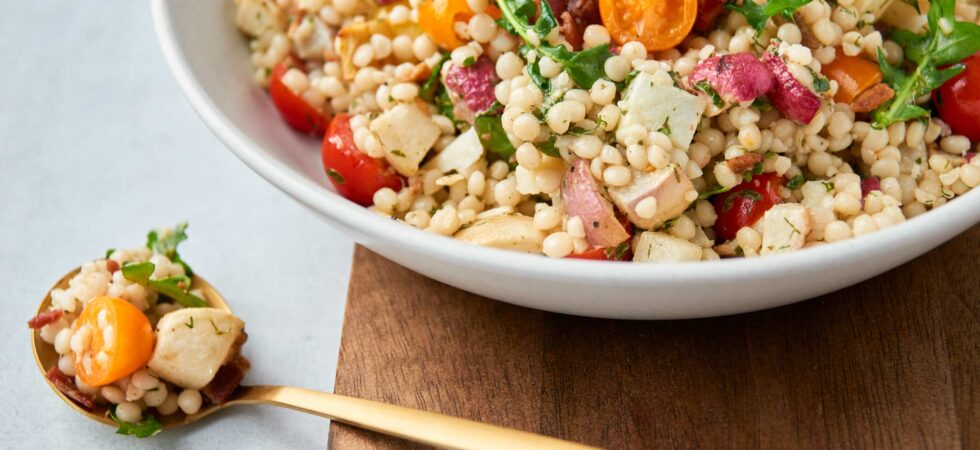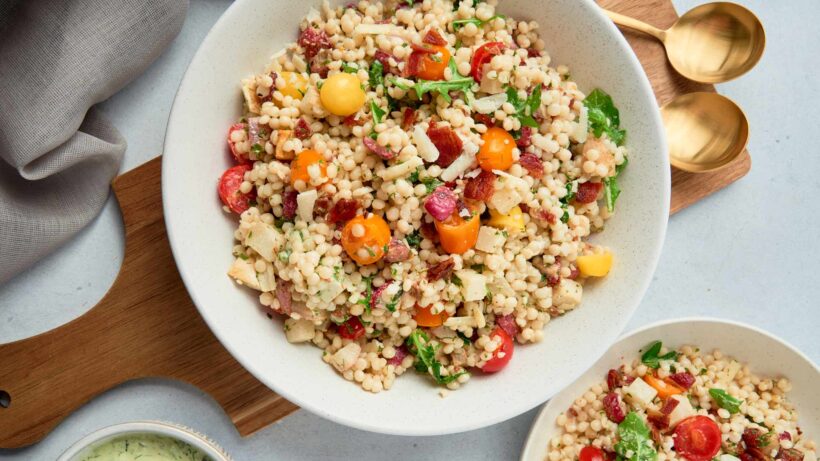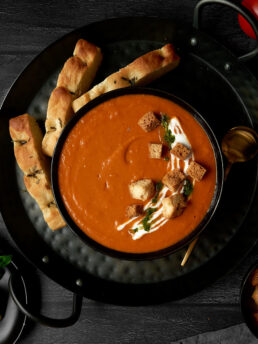Green Goddess Pasta Salad

So I woke up and wanted to throw ALL of my kids’ toys away, which means it’s spring in my household! In honor of that, I decided to leave squash soups behind and usher in spring with this epic Green Goddess pasta salad. I’m done with dreary. It’s time for picnics, cookouts, and pool days!
If you aren’t quite ready to leave soup season behind and want to baby step your way into spring, this recipe is great as a soup and “pasta salad” combo. Green Goddess Dressing and a mixture of roasted and fresh veggies makes this pasta salad the perfect replacement for the same old Italian dressing pasta salads.

Get the Recipe: Green Goddess Pasta Salad
Ingredients
- 2 tablespoons quality butter
- 1½ cups pearl couscous
- 2 cups water
- ½ teaspoon kosher salt, divided in half
- 4 tablespoons extra virgin olive oil, divided in half
- 1 cup diced radishes, cut into 1/2in (1.25cm) cubes (6-8 radishes)
- 2¼ cups diced turnips, cut into 1/2in (1.25cm) cubes (2 medium turnips)
- 3-4 strips cooked bacon , roughly chopped
- ⅓ cup green goddess dressing
- 1 cup cherry tomatoes, halved
- ¼ cup parmesan, grated
- 1 cup baby arugula/rocket, roughly chopped
Equipment
- Measuring spoons
- measuring Cups
- 1 large sauté pan/pot/dutch oven
- 1 chef knife
- 1 cutting board
- 2 quarter sheet baking tray
- 1 silicone baking mats (optional)
- aluminum foil
- 1 quarter sheet cooling rack
- 1 food processor or blender (if making the green goddess dressing)
- box grater (side with larger grater holes)
Instructions
- In a sauté pan heat the butter on med high until it starts to bubble, then add in the pearl couscous and stir around for 2-4 minutes lightly sautéing the pasta spheres. The butter will brown during this process as well. Once toasted, pour in the water and ¼tsp (.6g) of salt, turn the heat down to low, and cover. Cook the pasta to al dente (10-12 minutes).
- Once cooked, pour into a large serving bowl to cool, drizzle 2tbsp (30ml) olive oil over the pasta, and toss to coat. Give the pasta salad a toss every 10 minutes or so moving forward to promote cooling and stop clumping.
- Next, preheat your oven to 425°F (218°C).
- While the oven is preheating, chop up your turnips and radishes into ½in (1.25cm) cubes and lightly oil and salt them with the remaining amount of these ingredients. Put the chopped vegetables on a 13x18in (33×45.5cm) baking tray and place them into the oven. (bonus points if you use a silpat to keep everything from sticking to the pan)
- Bake for 25-30 minutes. You want them to be just fork tender.
- Prepare a second 13x18in (33×45.5cm) baking tray for the bacon by covering it in aluminum foil and setting a cooling rack onto the covered pan. Then place strips down on the rack and put them into the oven at the same temperature.
- The bacon should be crispy in about 15-25 minutes, depending on the thickness, but keep an eye on it. Bacon can go from crisp to charcoal really quick when you are not paying attention.
- If you plan to make the green goddess dressing from scratch (recipe takes 15 minutes max), make it now while the veggies and bacon are in the oven. Once the veggies and bacon are out of the oven, let them cool on the counter for 10-15 minutes.
- While they cool, halve the tomatoes, grate the parmesan, and give the arugula a rough chop. Once cool, chop up the bacon into small pieces and set that aside as well.
- Start assembling the pasta salad by adding all of the ingredients into the bowl and giving them a gentle mix. Once combined, add the dressing and toss to coat.
Notes
- Pearl couscous cooks like rice in that it should absorb all the water while it cooks. While there shouldn’t be any water left to drain when you take the cover off the pan/pot/dutch oven, if there is any water don’t panic. Drain off the excess cooking liquid and return the pasta to the pot. The pasta will absorb any leftover moisture as it cools. You might lose just a bit of flavor, but it’s nothing to worry about.
- Coating your pasta with olive oil after cooking will keep the pasta from sticking while it cools and you are preparing the rest of the ingredients. It also helps with texture of the pasta salad over all.
- Feel free to use an oil that has a milder flavor and higher smoke point to both roast the vegetables and coat the pasta. It’s really a matter of preference.
- So, I mentioned saving the dressing for last in the recipe because the pasta will soak it up over time. If you are taking this to a gathering, I suggest putting the dressing into a separate container and adding it just before eating. If you plan to eat immediately, the order of assembly doesn’t really matter.
Nutrition

Frequently Asked Questions
Pearl couscous, also known as or labeled as Israeli couscous, is a type of pasta made from semolina flour. It has a small, round shape and is similar in size to pearls, hence the name.
As with this recipe, it is typical to toast pearl couscous before boiling it like you would rice, to enhance its nutty flavor.
While traditional couscous is also made from wheat, it not considered pasta. This is because couscous is simply crushed durum wheat grains, not fully ground wheat mixed with other ingredients to form pasta. Because of its size and granularity, traditional couscous is typically cooked by steaming rather than boiling. It is also described as fluffy when cooked to tender.
Pearl couscous is actually pasta. It’s made from semolina flour and shaped into tiny pellets. Its larger size, requires a lot more water to cook and is usually toasted and boiled. Pearl couscous is chewy, like al dente pasta.
Luckily, there are other pastas that are a similar size and shape as pearl couscous. If you cannot find Israeli/pearl couscous look for these options:
1. Fregola (AKA fregola sarda or Sardinian couscous) is similar to pearl couscous in appearance, though its texture is rougher because it is made by hand. Like pearl couscous, it also has a slightly nutty flavor (thanks to the same roasting process during production). Unlike pearl couscous, you would not toast fregola in butter before boiling to enhance the nutty flavor. It is boiled like pasta and drained.
2. Acini di Pepe, meaning “peppercorns” in Italian, are small, round pasta pellets that can be used as a substitute. They are commonly used in soups, but can also be incorporated into salads or side dishes like this one! Skip toasting here too and cook Acini di Pepe just like you would pasta.
3. Orzo is the least like pearl couscous in this list, but it is also a fun pasta for pasta salad and it’s of similar size. You guessed it! Also cook orzo like pasta, drain, and then continue the recipe as written.
Sure! It’s not the end of the world if you decide not to sauté the pasta in butter before boiling like rice. It will still have some inherent nuttiness. Just know, you are losing some flavor when you skip this step.
Don’t panic! Grab your towel and use it to hold the pan/pot/Dutch oven over a colander in your sink. Strain off the extra liquid and return the pasta to your cooking vessel to cool. Add olive oil, toss to coat, and continue on with the recipe as written. No harm. no foul. Don’t worry about perfection!
That’s a big YES. Chicken or even veggie stock can add a ton of flavor to the pasta. Use caution on how much you use, especially if the stock is strongly flavored. It could overwhelm the more delicate flavors in the pasta salad. I recommend changing out no more than half of the water for stock. It’s also probably best if you do not use beef or seafood stock for the same overwhelming reason.
This is a fun question!
Here are a few ideas for spring and summer veggies. Double up on radishes or turnips instead of using both. Also try parsnips and/or rutabagas.
Closer to the end of summer and into early fall, consider using butternut squash, Brussel sprouts, and/or sweet potatoes.
If you don’t mind possibly getting the water to pasta ratio wrong and doing some draining, then absolutely! Have I done that before? You betcha!
Like rice, you cannot simply double or triple the water to pasta measurements. They won’t convert precisely. So, chances are you’ll have to do some draining. And, before you get any ideas; it would be better to over do it with the water than have too little. Not enough water means undercooked pasta.
Every other ingredient can simply be doubled by weight or volume. In fact, feel free to increase the amount of veggies to your liking. The Green Goddess Dressing recipe makes about 1 cup (240ml) so you can triple this recipe before you run out of dressing!



